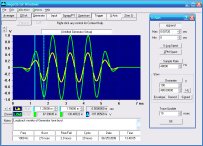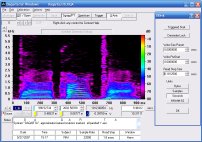![[LogoShip]](logo5.png)
Software for Windows
Science with your Sound Card!


Features:
Oscilloscope
Spectrum Analyzer
8-Channel
Signal Generator
(Absolutely FREE!)
Spectrogram
Pitch Tracker
Pitch-to-MIDI
DaqMusiq Generator
(Free Music... Forever!)
Engine Simulator
LCR Meter
Remote Operation
DC Measurements
True RMS Voltmeter
Sound Level Meter
Frequency Counter
Period
Event
Spectral Event
Temperature
Pressure
MHz Frequencies
Data Logger
Waveform Averager
Histogram
Post-Stimulus Time
Histogram (PSTH)
THD Meter
IMD Meter
Precision Phase Meter
Pulse Meter
Macro System
Multi-Trace Arrays
Trigger Controls
Auto-Calibration
Spectral Peak Track
Spectrum Limit Testing
Direct-to-Disk Recording
Accessibility
Data Logger
Waveform Averager
Histogram
Post-Stimulus Time
Histogram (PSTH)
THD Meter
IMD Meter
Precision Phase Meter
Pulse Meter
Macro System
Multi-Trace Arrays
Trigger Controls
Auto-Calibration
Spectral Peak Track
Spectrum Limit Testing
Direct-to-Disk Recording
Accessibility
Applications:
Frequency response
Distortion measurement
Speech and music
Microphone calibration
Loudspeaker test
Auditory phenomena
Musical instrument tuning
Animal sound
Evoked potentials
Rotating machinery
Automotive
Product test
Contact us about
your application!
MIDI Buffer Add Value Commands
Changes: BAvb.i0=(add,count)
The Buffer Add Value (BA) command allows a MIDI Changes script to modify a section of an input buffer by adding a specified amount to each note. (See Buffer Copy and Buffer Fill for getting notes into the buffer to be modified.)
The format for Buffer Add Value is BAvb.i0=(add,count), where v is Voice number 1-8, and b is buffer number 1-4. i0 is the index (position) where the addition should start, add is a the amount to add (which may be negative), and count is the number of notes to be affected.
i0, add, and count may use any unsigned integer or valid expression, including current MIDI control values, random values, current computer keyboard states or mouse position, input or buffered notes, oscillators, and User Variables. i0 will be limited to the 0-255 buffer range. add will be limited to +127/-128, and count will be limited such that the 256-note buffer size is not exceeded.
The actual notes resulting from the addition will be limited to the standard 0-127 MIDI note range.
Note: The Add Value operation detects if the note to be modified is a silent note from the Pitch Tracker, and if so that note is passed through without addition.
Unlike Buffer Copy and eXchange, Buffer Add Value may not be used with Voice Patterns.
You can use Set Pointers to set start and end note positions in the buffer, and Input Select to use it as the input stream for a Voice.
The normal Buffer Add BA command computes the add value once, and adds it to all buffer positions.
There is also a Ba variant that recomputes add for each position. If add is an expression that includes oscillators or random values, each position may have a different value added to it. This is useful for modifying bass, rhythm, or melody lines.
For example, Ba21.0=($a(-6,+6),8) would add 8 points from the oscillator $a output to Voice 2, buffer 1 starting from the 0th position.
The oscillator in this example is scaled such that a full cycle would swing between -6 and +6. The actual range covered by the 8 points used here would depend upon the frequency of the oscillator... a low frequency might not move very much in only 8 points.
A use-based (lower case) oscillator $a to $h is usually best for inclusion in add, because its output is computed on every use. A frequency-based oscillator $1 to $8 or a beat-based oscillator $A to $H will act as a constant whose value is the current output of the oscillator at the beat when the command is processed.
See also Changes Script Buffer Operations, Changes Script Overview, Changes Script Editor, MIDI Voice Setup Dialogs, Pitch-to-MIDI dialog, Pitch Track Toolbox - Overview
- Back to MIDI Buffer Pivot Command
- Ahead to MIDI Buffer Fill Commands
- Daqarta Help Contents
- Daqarta Help Index
- Daqarta Downloads
- Daqarta Home Page
- Purchase Daqarta
Questions? Comments? Contact us!
We respond to ALL inquiries, typically within 24 hrs.INTERSTELLAR RESEARCH:
Over 35 Years of Innovative Instrumentation
© Copyright 2007 - 2023 by Interstellar Research
All rights reserved